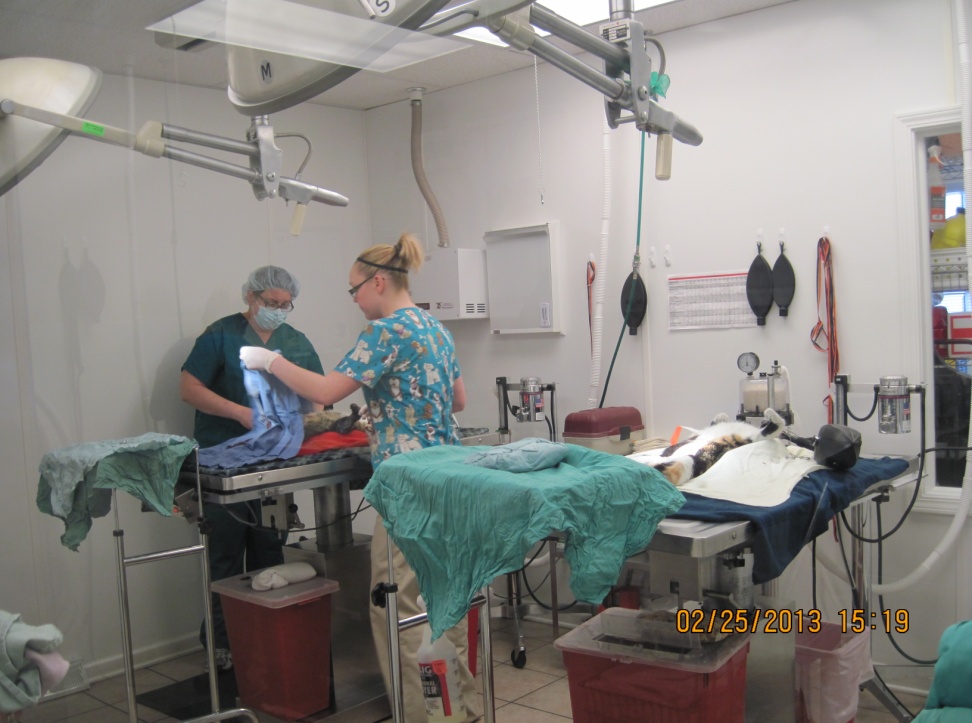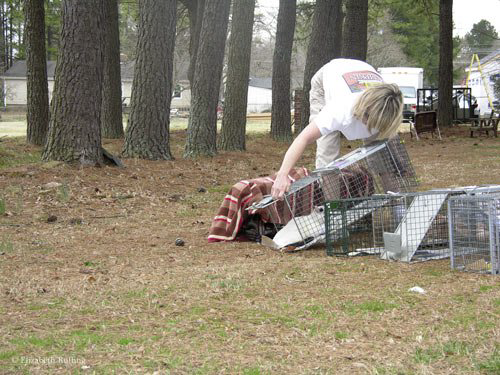Spay/Neuter Post-Surgery Care
- ABOUT THE SURGERY
- THE CAT MUST RECOVER OVERNIGHT IN THE TRAP
- RECOVERY FOR LACTATING MOMS & PREGNANT PRIOR TO SURGERY
- ROUTINE RECOVERY HOLDING
- CATS MUST BE MONITORED CLOSELY FOLLOWING SURGERY
- FEEDING
- HOLD CATS UNTIL THEY RECOVER
- RETURN THE CAT TO WHERE IT WAS TRAPPED
- NEVER RELEASE THE CAT INTO A NEW AREA
ABOUT THE SURGERY
Your cat has had a surgical procedure. All cats – both male and female – are anesthetized.
Female cats are spayed by removing their reproductive organs. They will have an incision on their abdomen. The inside has been sutured and the outside has been glued. All skin sutures are absorbable and do not need to be removed. (Note: All female cats spayed at Operation PETS Spay/Neuter Clinic will have a green-blue tattoo at their incision site.)
Male cats are neutered by removing their testicles. Some remaining skin of the sack will be present. All skin sutures are absorbable and do not need to be removed.

All feral and free roaming cats will have had their left ear tipped while under anesthesia. They will also receive a rabies vaccine and a distemper vaccine.
When you arrive to pick up the cat post surgery the cat should be fully awake, but may not be fully alert. They will still be groggy from anesthesia.
All cats recovering from anesthesia are unpredictable. Do not stick your fingers through the bars or attempt to handle the cats. Do not open the trap door or attempt to handle the cat. This can have serious consequences such as injury to the cat, injury to you, or the cat getting loose in an area that is not familiar to them.
The cats need to be monitored closely following surgery. Be sure to ask the clinic where you took the cat/s how to reach them if there are surgical complications. Follow the post-surgery discharge instructions given to you by the veterinary clinic.
THE CAT MUST RECOVER OVERNIGHT IN THE TRAP
In order to recover from anesthesia and surgery, all cats MUST stay in their trap the night following surgery. No exceptions!!
It is not cruel to leave a feral cat in their trap – even for a few days if needed. Feral cats don’t react like a tame cat. They tend to remain still and in one place. They prefer to be in tighter, darker spaces rather than wide open enclosures (they feel more secure). If the trap is kept covered the cat will huddle at one end of the trap and eat at the other and will be perfectly fine. Do not worry if they defect or urinate. Cats usually need to be held for 24 hours after surgery, depending on recovery speed. Male cats and often females can be returned to the trapping site 12 to 24 hours following surgery, as long as they are fully awake and do not require further medical attention. Please see Feral Cat Set-Up for Long Term Fosters if you have to hold the cat longer than 72 hours.
Plan the release according to the weather, time of day, traffic flow, kids getting out of school, etc. Make sure there is no nearby danger, such as a busy street. It is best to return cats at either dawn or dusk because the cats have more control of the area at theses times and there will be no construction, heavy traffic, etc.
LACTATING MOMS & PREGNANT PRIOR TO SURGERY
In some cases, females may need 48 hours of recovery, depending on their specific circumstances. If you have a female cat that was pregnant, please try to keep her in for a few extra days, this will give her time to regain her strength. Keep feeding her and keep her warm if the weather is cold.
A lactating female must be released 10-12 hours after surgery so she can return to her kittens. Once a nursing mother has completely regained consciousness you may return her as soon as possible so she can get back to caring for her kittens. You can also get the kittens and only AFTER the mother is fully awake and alert following surgery put the kittens in a size appropriate cage or crate with their mother (do not put the kittens in the trap with the mother!).
For females that need a longer recovery see Feral Set-Up for Long-Term Fosters.
ROUTINE RECOVERY HOLDING
Following surgery cats need a temperature-controlled place to recover. In the hours after surgery, a cat’s body temperature will drop, so they MUST be kept covered and warm until released. The recovery location should be safe, secure, dry, quiet and warm. It is important that the area is temperature-controlled to keep the cats from getting too hot or too cold.
Keep the cats indoors in their covered traps and keep them away from loud noises or dangers such as toxic fumes, other animals, or people.
Keep the traps covered to reduce the cat’s stress.
Never open the trap doors or allow the cat out of the trap. Never attempt to handle the cat. This can have serious consequences such as the cat getting loose in an area that is not familiar to them, injury to the cat or injury to you.
Place newspapers or a towel under the trap to absorb urine and feces.
Spread a plastic cloth or tarp on the ground. This will protect any urine or other waste from getting on the floor.
If possible place traps off the floor on wood planks or tables covered with newspapers and plastic to protect floors and keep cats from getting cold. Don’t put cats on a cement floor. Put tables on a ground cloth and cover table with plastic.
Place the traps several inches apart, each one covered with a trap cover, sheet or large towel. Have the rear and front doors of all the traps facing the same way.
MONITOR CATS CLOSELY FOLLOWING SURGERY
The cat may be groggy after surgery, but should be fully awake by the evening.
The cat might not urinate or defecate during the first day or two of the recovery.
Monitor well to ensure that cat is breathing normally and is not bleeding from the surgical site or ear tip site. Check the cats often for their progress; keep an eye out for bleeding, infection, illness, and lack of appetite. If the cat does not show signs of recovering, call your veterinary clinic as soon as possible for further instructions.
(NOTE: If you took cats to Operation PETS Spay/Neuter Clinic of WNY the cats will have newspaper and light colored cloth in the bottom of the trap. The light cloth will help to monitor if the cat is bleeding. The several layers of newspaper will absorb urine. The cat will move away from any feces.)
Some blood/spotting is possible but an excess of blood (puddle or pooling) is not good. If you witness this, call the clinic that spayed or neutered your cat for further instructions. DO NOT WAIT – CALL IMMEDIATELY.
Abnormal behaviors include continual bleeding from the surgery area, prolonged recovery time (still inactive and lethargic, 6+ hours after surgery) or getting drowsy or weak again after waking up. DO NOT WAIT – Contact your veterinarian immediately.
If a cat is vomiting, bleeding, having difficulty breathing, or not waking up, DO NOT WAIT – Contact your veterinarian immediately.
If a cat is vomiting while still unconscious, her head should be turned to avoid choking. Sometimes this can be achieved by gently tipping the trap to no more than a 30 degree angle to change the cat’s position. Be careful when tipping the trap so that you don’t harm the cat by jostling her too much.
FEEDING
DO NOT open the trap doors for any reason!
In the evening on the day of surgery, offer the cat food. Mix canned food with water, roll into ball, and drop through the bars into the trap.
Do not place a water dish in the trap, feeding canned food gives them the moisture they need for the time while they are in the trap.
Remember to continue to feed the cat regularly during the recovery confinement period.
Offer food again in the morning before release but don’t be concerned if the cat is not interested in the food. Sometimes they are too scared and stressed to eat.
HOLD CATS UNTIL THEY RECOVER
Make sure all cats are fully conscious, clear-eyed, and alert before release.
Cats usually need to be held for 24 hours after surgery, depending on recovery speed. Cats can be returned to the trapping site 12-24 hours following surgery as long as they are fully awake and do not require further medical attention. In some cases, females may need 48 hours of recovery, depending on their specific circumstances.
A lactating female must be released 10-12 hours after surgery so she can return to her kittens. Once a nursing mother has completely regained consciousness you may return her as soon as possible so she can get back to caring for her kittens. You can also get the kittens and only AFTER the mother is fully awake and alert following surgery put the kittens in a size appropriate cage or crate with their mother (do not put the kittens in the trap with the mother!). Feral Cat Set-Up for Long Term Fosters.
If the cat is not recovering well from surgery for any reason (no longer than 48 hours) and needs further care, please seek medical care. Call the veterinary hospital or clinic that performed the surgery.
RETURN THE CAT TO WHERE IT WAS TRAPPED
Make sure all cats are fully conscious, clear-eyed, and alert before release. Be sure the cat does not require any further medical care before releasing it from trap.
Release the cat(s) at the site where they were trapped.
Plan the release according to the weather, time of day, traffic flow, kids getting out of school, etc. Make sure there is no nearby danger, such as a busy street. It is best to return cats at either dawn or dusk because the cats have more control of the area at theses times and there will be no construction, heavy traffic, etc.
Put the trap down on the ground and let the cat get reoriented to where he/she is for about five minutes.

Pull the cover away from the back door, pull the back door up and off, then completely remove the cover and walk away. If your trap does not have a back door release stand behind the trap and open the trap door from behind (see picture).
Do not be concerned if the cat hesitates a few moments before leaving. She is simply reorienting herself to her surroundings.
Provide fresh water and food.
The cat may disappear for a few hours or a couple of days after release but will eventually return. Resume the feeding schedule and continue to provide food and water — he/she may eat when you are not around. NEVER FEED AT NIGHT.
After release, frequent visits should be made to the site to ensure that the cat has fully resumed it regular habits and there are no complications.
NEVER RELEASE THE CAT INTO A NEW AREA
Never release the cat into a new area unless you have thoroughly talked to a Feral Cat FOCUS volunteer on proper relocation protocol. Feral Cat FOCUS does not recommend relocation and it should only be done under extreme circumstances when the cats’ lives are in eminent danger. Moving a colony of feral cat/s is a complex process that involves specific procedures to achieve success. Remember! In the very best of circumstances, relocation might not work. For more information on feral cat relocation see HOW TO SAFELY RELOCATE FERAL CATS.
